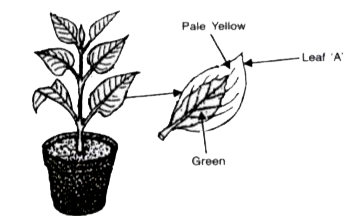The process of photosynthesis is
Reductive, exergonic and catabolic
Reductive, endergonic and catabolic
Reductive, exergonic and anabolic
Reductive, endergonic and anabolic.
The correct Answer is:D
Step-by-Step Solution:
1. Understanding Photosynthesis: Photosynthesis is the process by which green plants, algae, and some bacteria convert light energy into chemical energy in the form of glucose. This process primarily occurs in the chloroplasts of plant cells.
2. Identifying the Nature of Photosynthesis:
- Anabolic Process: Photosynthesis is classified as an anabolic process because it builds larger molecules (glucose) from smaller molecules (carbon dioxide and water). Anabolism refers to the synthesis of complex molecules from simpler ones.
- Endergonic Reaction: Photosynthesis is also an endergonic process, meaning it requires energy input. In this case, the energy comes from sunlight, which is absorbed by chlorophyll.
3. Oxidation-Reduction Reactions:
- During photosynthesis, water (H₂O) is oxidized, meaning it loses electrons and is converted into oxygen (O₂). This is a reduction reaction where the water molecules are broken down to release oxygen.
- Carbon dioxide (CO₂) is reduced, meaning it gains electrons to form glucose (C₆H₁₂O₆). This is the building of a larger molecule from smaller ones.
4. Conclusion: Based on the characteristics of photosynthesis, it can be summarized as:
- Reductive: It involves the reduction of carbon dioxide to glucose.
- Endergonic: It absorbs energy from sunlight.
- Anabolic: It builds larger molecules (glucose) from smaller ones (water and carbon dioxide).
5. Final Answer: Therefore, the correct classification of the process of photosynthesis is reductive, endergonic, and anabolic.
- Anabolic Process: Photosynthesis is classified as an anabolic process because it builds larger molecules (glucose) from smaller molecules (carbon dioxide and water). Anabolism refers to the synthesis of complex molecules from simpler ones.
- Endergonic Reaction: Photosynthesis is also an endergonic process, meaning it requires energy input. In this case, the energy comes from sunlight, which is absorbed by chlorophyll.
- During photosynthesis, water (H₂O) is oxidized, meaning it loses electrons and is converted into oxygen (O₂). This is a reduction reaction where the water molecules are broken down to release oxygen.
- Carbon dioxide (CO₂) is reduced, meaning it gains electrons to form glucose (C₆H₁₂O₆). This is the building of a larger molecule from smaller ones.
- Reductive: It involves the reduction of carbon dioxide to glucose.
- Endergonic: It absorbs energy from sunlight.
- Anabolic: It builds larger molecules (glucose) from smaller ones (water and carbon dioxide).
Topper's Solved these Questions
- PHOTOSYNTHESISBOOK - DINESH PUBLICATION ENGLISHCHAPTER - PHOTOSYNTHESISEXERCISE - CYG
10 Videos
- ORIGIN OF LIFE BOOK - DINESH PUBLICATION ENGLISHCHAPTER - ORIGIN OF LIFE EXERCISE - All Questions
201 Videos
- PHYLUM - ANNELIDABOOK - DINESH PUBLICATION ENGLISHCHAPTER - PHYLUM - ANNELIDAEXERCISE - Check your grasp
10 Videos
Similar Questions
(a) What a photosynthesis ?
(b) Write a chemical equation to show the process of photosynthesis in plants.
(c) Explain the mechanism of photosynthesis
View SolutionA potted plant with variegated leaves was taken in order to prove a factor necessary for photosynthesis. The potted plant was kept in the dark for 24 hours and then placed in bright sunlight for a few hours Observe the diagrams and answer the questions.

Represent the process of photosynthesis in the form of a balanced equation
View Solution
Knowledge Check
Which of the following factors, besides being one of the reactants in the process of photosynthesis, indirectly affects its rate?
AOxygenBCarbon dioxideCWaterDChlorophyll
Describe any three external factors affecting the process of photosynthesis
View SolutionIn the process of photosynthesis , water moleculs breaks is
View SolutionFor the process of photosynthesis, which one of the following is not essential ?
View SolutionDuring the process of photosynthesis the raw material used are
View SolutionO2 released in the process of photosynthesis comes from
View SolutionWhich property of the pigment is responsible for its ability to initiate the process of photosynthesis ? Why is the rate of photosynthesis higher in the red and blue regions of the spectrum of light ?
View SolutionDescribe how the processes of photosynthesis and cellular respiration are linked, and what aspects they have in common.
View Solution
